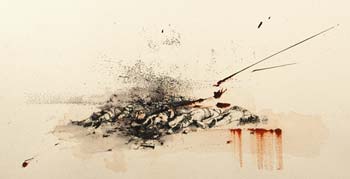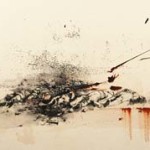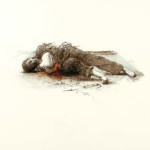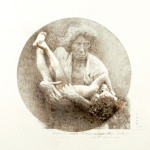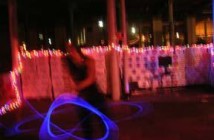Newspapers offer us images of death and pain caused by wars, governmental injustices, physical abuse and torture with such frequency that over time, we tend to gloss over them. Yet upon closer examination, some of these victims appear quite beautiful, lifeless yet graceful in death. Although they will likely remain anonymous to us personally, they demand our attention as deceased victims of painful circumstances, quiet remnants of psychological and physical brutality. Even photographs of the survivors of tragic encounters, like mourning mothers carrying their dead and lone, observant children, deserve closer examination. Elaine Spatz Rabinowitz could not agree more. Her delicate war drawings on paper (delicately combined with other forms of media) are based on document photographs from the New York Times, taken in countries as diverse as Iraq, Afghanistan, Spain, and Russia, photographs of models composed in her studio and images from books. In their universal quality, emotional intensity and sense of realism, they recall Goya’s “Disasters of War” etchings, documenting the horrors of the Napoleonic guerilla war in Spain (1808 -14); Kathe Kollwitz’s etchings, drawings and prints documenting the impact on the poor in Germany (late 19th – early 20th century); as well as Dorothea Lange’s black and white photographs of migrating farmers and their families fleeing the Dust Bowl in the 1930’s.
In Rabinowitz’ work entitled “The New York Times, November 21, 2004” (2005), the central group of bodies reminds us of the assemblage of corpses in Goya’s etching “Muertos Recogidos” or “Gathered Dead” (1863). In a contemporary vein, Rabinowitz adds color and additional media. She draws us into the composition with a translucent wash of red pigment emerging from the bodies; a small succession of bloody drips, smeared into downward lines; two quickly flung thin black lines of paint moving upwards to the right of the figures; and a few painted accents in black. All touches of pigment work together to stress the tragic nature of the event. The barbed wire wrapped around the mid section of the dead figure in “Untitled”, 2005 causes a mass of red blood to emerge. The subject dies wearing a “crown of thorns” on his body and suffers with dignity, like Christ in Goya’s painting “Christ Crucified” (1780).
In her drawing “The New York Times, undated” (2005), the serious, intense expression of a woman carrying a dead child, defined by deep lines and the solemn downturn of her mouth, recalls the emotional intensity in Kollwitz’ “Woman with Dead Child” (1903) and “The Survivors” (1923). She also bears the signs of a tattered life, much like the 32 year old mother in Dorothea Lange’s “Migrant Mother” (1936), weathered beyond her years, who sits in contemplation with three of her seven children. Yet unlike the works of Kollwitz and Lange, Rabinowitz deliberately softens the mood of the composition, enhancing the tone of the dead child’s skin and adding a chestnut color to her healthy long curls.
Elaine Spatz Rabinowitz’ war drawings allure through her delicate, romantic treatment of death and suffering, causing us to see the beauty within the remains of destruction.
Links:
Howard Yezerski Gallery
"Elaine Spatz Rabinowitz: War Drawings" is on view October 14 - November 15, 2005 at Howard Yezerski Gallery.
All images are courtesy of the artist and Howard Yezerski Gallery.
- Elaine Spatz Rabinowitz, The New York Times, November 21, 2004, (detail) Mixed Media, 2005.
- Elaine Spatz Rabinowitz, Untitled, (detail) Mixed Media, 2005.
- Elaine Spatz Rabinowitz, The New York Times, date unknown (detail), Mixed Media, 2005.

